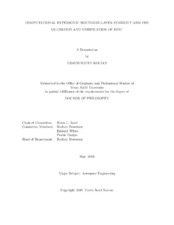| dc.description.abstract | Laminar-to-turbulent transition is a process that is critical in determining the system drag and surface heating of a flight vehicle, and the ability to predict, and possibly control, this process has become an essential component in vehicle design. The linear and nonlinear parabolized stability equations provide a method of analyzing different regions of the flowfield around a vehicle in a way that is both efficient and accurate. These methods have continued to evolve in terms of both capability and robustness. Coupled with data from wind tunnel experiments, they provide a powerful tool in understanding and addressing flow phenomena involved in the process of laminar-to-turbulent transition.
EPIC is a parabolized stability equations (PSE) solver developed within the Computational Stability and Transition laboratory at Texas A&M University that can address both the linear and nonlinear aspects of the stability problem. This capability provides a means to evaluate different instabilities and the underlying physics that drives them. PSE results are computed for several hypersonic geometries including the Langley 93-10 cone, Purdue compression cone, yawed straight cone, and HIFiRE-5 elliptic cone. Disturbances that are both two-dimensional and three-dimensional in nature are analyzed and compared with results obtained from direct numerical simulations, wind tunnel experiments, and alternate PSE codes. In addition, techniques for modeling stationary crossflow vortex paths and the evolution of spanwise wavenumber from the basic-state solution are formulated. | en |


